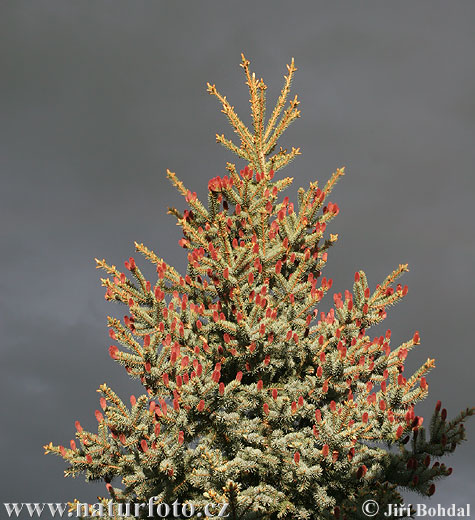
Classification
 Picea pungens
or more commonly the Colorado Blue Spruce derives its name from its
blue, almost silvery-blue color. In 1939 it was named the state tree of
Colorado and ever since then has been called the Colorado Blue
Spruce ever since. Picea is derived from the Latin word pix, or
pitch, referring to the resin its bark contains, and pungens
translates as "sharp-pointed," referring to the needles.
Picea pungens
or more commonly the Colorado Blue Spruce derives its name from its
blue, almost silvery-blue color. In 1939 it was named the state tree of
Colorado and ever since then has been called the Colorado Blue
Spruce ever since. Picea is derived from the Latin word pix, or
pitch, referring to the resin its bark contains, and pungens
translates as "sharp-pointed," referring to the needles.
Domain Eukarya: Members of this domain have
membrane-bound organelles, have their DNA organized into chromosomes
located in a nucleus and are more diverse than any other domain of life.
Other domains consist of Archaea and Bacteria.
Kingdom Plantae: Members of this Kingdom have a cell
wall made of cellulose, and store their food as starch. They are also
photosynthetic which means they are autotrophic, having the ability to produce their
own food for energy. Other Kingdoms consist of Animalia, Fungi and
Protista
Phylum Coniferophyta: Members of this Phylum have seeds
and are vascular, meaning they have vascular tissues which circulate
nutrients and resources throughout the plant.
Class Coniferae: This class contains the conifers.
These are cone-bearing plants. Their seeds are housed in these cones.
Other members include cypresses, firs, kauris, larches, pines, cedars
and redwoods.
Order Pinales: Members of this order are woody plants
and are comprised mainly of trees. Other members include yews, junipers,
redwoods, larches, cedars and pines.
Family Pinaceae: Members of the pine family are almost
entirely trees, mostly evergreen. They are monoecious, meaning they have both
sets of sex organs on one organism. Pines are also resinous and affiliates have
linear, needle-like leaves. Others members include cedars, pines,
larches and hemlocks.
Genus Picea A. Dietr.: Spruces
Species Picea pungens
From this phylogeny we can see a close relation between the Spermatopsida (the seed plants, flowering plants, and conifers) and the Archaeopteridales (include genus Callixylon) and Protopityales. Conifers, flowering plants and seed plants also share a near common ancestor with Polypodiopsida (the ferns). More distant relatives of the Spermatopsidae include the Bryophytes (mosses), Anthocerotophytes (hornworts), and the Marchantiomorphae (liverworts).


This phylogenetic tree, the relationship among all spermatopsida is
shown. P. pungens, a member of the Conifers, is shown to be most
closely related to the Cordaitopsidas. Beyond that, you can see that the
Conifers have common ancestors with most of the other spermatopsida,
including, but not limited to Ginkgos, Cycads, and Angiosperms (or
flowering plants). Among the least related to the Conifers, under the
limb of spermatopsida, are the Calamopityaceae (members include B.
perplexa) and the Hydraspermaceae. Another relative quite far in
relation to
the Conifers is Lyginopteridaceae (members include E. polymorpha).
 Cladistic trees have been created using chloroplast DNA
variation as well as molecular data analysis (shown in the cladistic
tree below). For more information on this type of work
click here.
Cladistic trees have been created using chloroplast DNA
variation as well as molecular data analysis (shown in the cladistic
tree below). For more information on this type of work
click here.